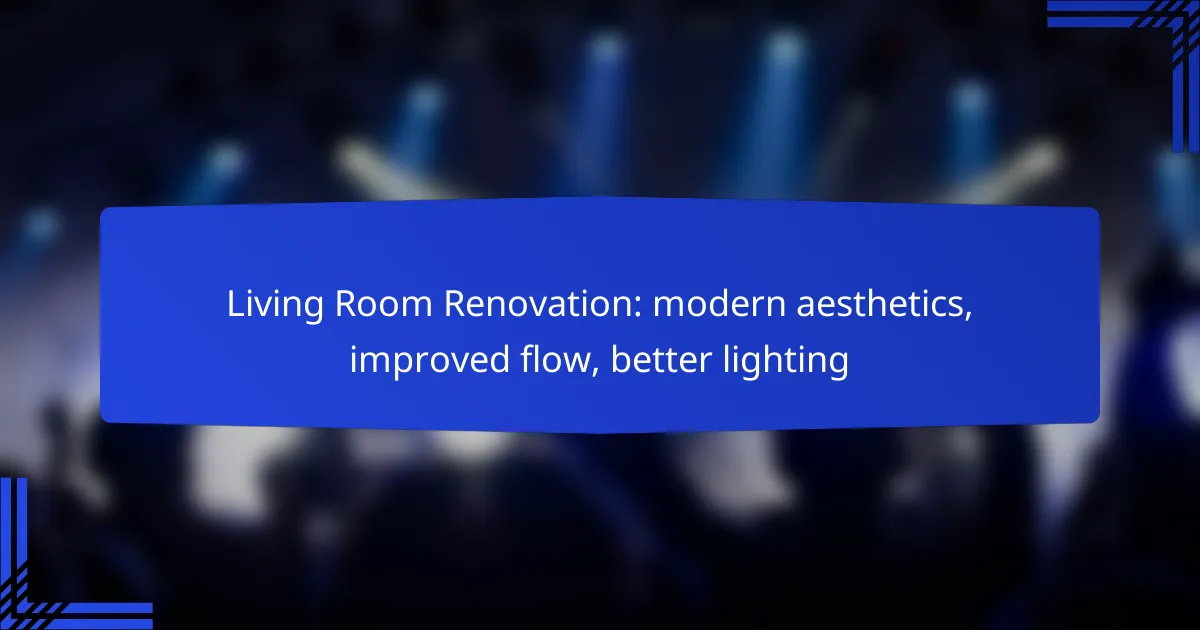Renovating your living room with a focus on modern aesthetics, improved flow, and better lighting can transform the space into a stylish and functional haven. By embracing simplicity and cohesive design elements, you can enhance visual appeal while promoting an inviting atmosphere. Additionally, optimizing the layout and lighting will create a seamless environment that encourages movement and interaction, making your living room a perfect gathering spot.

How to achieve modern aesthetics in living room renovation?
To achieve modern aesthetics in your living room renovation, focus on simplicity, functionality, and a cohesive design. This involves selecting furniture, colors, and technology that enhance the space’s visual appeal while promoting a sense of openness and flow.
Use of minimalist furniture
Minimalist furniture emphasizes clean lines and functional design, which can significantly enhance modern aesthetics. Opt for pieces that serve multiple purposes, such as a coffee table with storage or a sofa bed, to maximize space efficiency.
Choose furniture with a low profile and avoid overly ornate designs. Materials like metal, glass, and light woods can create an airy feel, while neutral upholstery allows for easy coordination with other decor elements.
Incorporate neutral color palettes
A neutral color palette is essential for modern aesthetics, as it creates a calming and cohesive environment. Shades like whites, grays, and beiges can make the space feel larger and more inviting.
Consider using a mix of textures within your neutral palette, such as soft textiles and smooth surfaces, to add depth without overwhelming the eye. Accent colors can be introduced through accessories like cushions or artwork, but keep them subtle to maintain the overall modern look.
Integrate smart home technology
Integrating smart home technology can enhance both the functionality and aesthetics of your living room. Devices such as smart lighting, thermostats, and speakers can be seamlessly incorporated into your design, allowing for a streamlined appearance.
Choose technology that blends with your decor, such as smart bulbs that can change colors or smart speakers that can be hidden within furniture. This not only improves convenience but also supports the modern aesthetic by reducing visual clutter.

What are the best ways to improve flow in a living room?
Improving flow in a living room involves creating an open and inviting space that facilitates movement and interaction. Key strategies include adopting an open floor plan, strategically placing furniture, and using area rugs to define zones.
Open floor plan design
An open floor plan removes barriers between the living room and adjacent spaces, enhancing the overall flow. This design encourages natural light to permeate the area and fosters a sense of connection between rooms.
When considering an open layout, think about how your living room interacts with the kitchen or dining area. Ensure that sightlines are clear and that furniture arrangements do not obstruct pathways. This can often mean removing unnecessary walls or using partial dividers like shelves.
Strategic furniture placement
Furniture placement is crucial for maintaining flow in a living room. Arrange seating to promote conversation and create clear pathways for movement. Aim for a layout that allows at least 24 to 36 inches of space between furniture pieces for easy navigation.
Consider using a focal point, such as a fireplace or television, to guide your arrangement. Avoid placing large pieces in the center of the room, as this can create obstacles. Instead, group smaller furniture items to encourage interaction while keeping the space open.
Use of area rugs for zoning
Area rugs can effectively define different zones within a living room, enhancing flow while adding visual interest. By placing rugs under furniture groupings, you can create distinct areas for lounging, reading, or entertaining.
Choose rugs that complement your overall design while ensuring they are large enough to fit under the front legs of your furniture. This helps unify the space and reinforces the flow between zones. Avoid overly busy patterns that may distract from the room’s overall harmony.

How can lighting be enhanced in living room renovations?
Enhancing lighting in living room renovations involves a combination of strategies that improve both functionality and aesthetics. By focusing on layered lighting, maximizing natural light, and incorporating energy-efficient fixtures, you can create a well-lit, inviting space.
Install layered lighting solutions
Layered lighting combines ambient, task, and accent lighting to create a balanced illumination in your living room. Ambient lighting provides overall brightness, while task lighting focuses on specific areas, such as reading nooks or workspaces. Accent lighting highlights artwork or architectural features, adding depth and interest.
Consider using a mix of ceiling fixtures, floor lamps, and table lamps to achieve this effect. Dimmers can also enhance versatility, allowing you to adjust the brightness based on the time of day or activity.
Utilize natural light through windows
Maximizing natural light is a key element in enhancing your living room’s lighting. Strategically placed windows, skylights, or glass doors can significantly increase daylight exposure. Use light-colored curtains or blinds that can be easily opened to allow sunlight in.
Incorporating reflective surfaces, such as mirrors or glossy finishes, can help bounce light around the room, making it feel brighter and more spacious. Consider the orientation of your windows; south-facing windows typically receive the most sunlight throughout the day.
Incorporate LED fixtures
LED fixtures are an excellent choice for modern living room renovations due to their energy efficiency and longevity. They consume significantly less electricity than traditional bulbs and can last for tens of thousands of hours, reducing replacement costs over time.
When selecting LED fixtures, look for options that offer adjustable color temperatures, allowing you to create a warm or cool ambiance based on your preference. Additionally, consider smart LED systems that can be controlled via smartphone apps for added convenience and flexibility.

What are the key considerations for selecting materials?
When selecting materials for a living room renovation, consider factors such as durability, maintenance requirements, and eco-friendliness. These aspects will significantly impact the overall aesthetic, functionality, and sustainability of your space.
Durability and maintenance
Durability is crucial for materials used in high-traffic areas like the living room. Opt for materials that can withstand wear and tear, such as hardwood flooring or high-quality tile, which typically last for years with minimal upkeep.
Maintenance is another key factor; choose materials that are easy to clean and maintain. For instance, leather or synthetic upholstery can be wiped down easily, while natural fabrics may require more frequent cleaning and care.
Eco-friendly options
Eco-friendly materials are increasingly popular in living room renovations. Look for options such as bamboo flooring or recycled glass tiles, which reduce environmental impact while providing a modern aesthetic.
Additionally, consider low-VOC (volatile organic compounds) paints and finishes to improve indoor air quality. These products are better for both the environment and your health, making them a wise choice for a living space.

How to budget for a living room renovation?
Budgeting for a living room renovation involves estimating costs for materials, labor, and unexpected expenses. A well-planned budget helps ensure that you can achieve your desired modern aesthetics, improved flow, and better lighting without overspending.
Estimate costs for materials
Begin by researching the costs of materials needed for your renovation. This includes flooring, paint, lighting fixtures, and furniture. Prices can vary widely; for instance, hardwood flooring might range from $5 to $15 per square foot, while paint can cost between $20 and $60 per gallon.
Consider the quality and style of materials you want. Higher-end options may enhance aesthetics but will increase your budget. Creating a list of necessary materials with estimated costs can help you stay organized and focused.
Consider professional labor costs
Labor costs can significantly impact your renovation budget. Hiring professionals for tasks like electrical work, plumbing, or carpentry typically ranges from $50 to $150 per hour, depending on the complexity of the job and local rates. It’s advisable to get multiple quotes to ensure you’re getting a fair price.
Evaluate whether some tasks can be DIY projects to save on labor costs. However, be cautious; improper execution can lead to additional expenses later. Prioritize hiring professionals for critical tasks that require expertise.
Plan for unexpected expenses
Unexpected expenses are common in renovations, often accounting for 10% to 20% of your total budget. These can arise from structural issues, code compliance, or changes in design plans. Setting aside a contingency fund can help you manage these surprises without derailing your project.
Regularly review your budget as the renovation progresses. If you notice certain areas exceeding your estimates, adjust other parts of your budget accordingly. This proactive approach can help you maintain financial control throughout the renovation process.

What are the latest trends in living room design?
The latest trends in living room design focus on modern aesthetics, improved flow, and enhanced lighting. Homeowners are increasingly prioritizing open layouts, multifunctional spaces, and natural light to create inviting environments.
Modern aesthetics
Modern aesthetics in living room design emphasize clean lines, minimalism, and a neutral color palette. Popular choices include shades of white, gray, and beige, often accented with bold colors through accessories like cushions or artwork.
Materials such as wood, metal, and glass are frequently used to create a contemporary feel. Incorporating textures through rugs, throws, and wall art can add depth while maintaining a streamlined appearance.
Improved flow
Improving flow in a living room involves creating a seamless transition between spaces. Open floor plans are favored, allowing for easy movement and interaction among family members and guests.
To enhance flow, consider furniture arrangement that encourages conversation, such as placing sofas and chairs in a U-shape. Avoid overcrowding the space with too much furniture, and opt for multifunctional pieces that can adapt to various needs.
Better lighting
Better lighting is essential for a well-designed living room, combining natural and artificial sources. Large windows and glass doors can maximize daylight, while layered lighting—using ambient, task, and accent lights—creates a warm and inviting atmosphere.
Incorporating dimmers can provide flexibility, allowing you to adjust the brightness according to the time of day or activity. Consider using floor lamps, table lamps, and wall sconces to enhance the overall lighting scheme and highlight key design elements.
